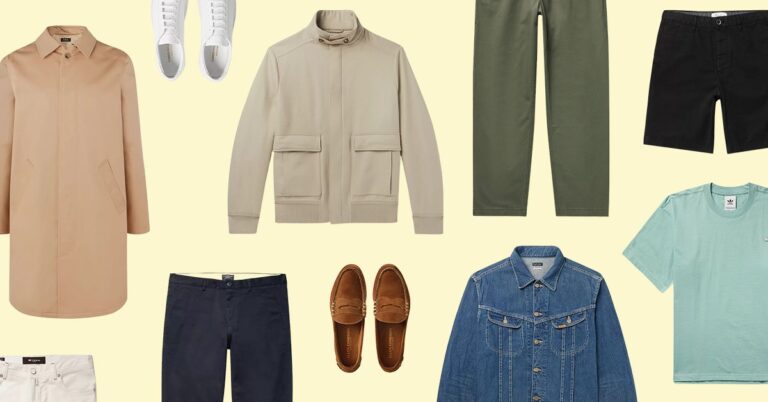The What to Wear Temperature Chart provides guidance on appropriate clothing choices based on the current temperature. When planning your outfit, consult this chart to ensure you are dressed comfortably for the weather conditions.
With a range of temperatures and corresponding clothing recommendations, this chart makes it easy to determine what to wear to stay warm or cool throughout the day. Whether it’s a hot summer day or a chilly winter morning, this temperature chart will help you dress appropriately and stay comfortable no matter the season.
So, let’s dive into the details of this chart and make dressing for the weather a breeze.
Spring Fashion
Spring is a season of transition, with temperatures fluctuating throughout the day. Dressing appropriately for these changing weather conditions can be challenging, but with the right pieces and accessories, you can stay stylish and comfortable. Layering is key during this time, allowing you to easily adapt to the unpredictable weather. Consider wearing a light jacket or cardigan over a spring dress or pairing a sweater with a skirt or jeans. This way, you can remove or add layers as needed. Investing in versatile transitional pieces such as a denim jacket or a trench coat is also a wise choice. These timeless items can be paired with various outfits and easily mixed and matched. Along with layers, accessorizing is essential in achieving a polished spring look. Opt for statement jewelry, colorful scarves, and stylish hats to add a touch of personality to your outfits. Remember to choose accessories that are both functional and fashionable. With these layering and accessory tips, you can effortlessly navigate the fluctuating temperatures of spring.
Summer Fashion
When it’s hot outside, it’s important to choose the right clothes that keep you comfortable and stylish. Opt for breathable fabrics to stay cool in the summer heat. Fabrics like cotton, linen, and silk are great choices as they allow air to circulate and absorb moisture. Look for garments that are loose-fitting and have light colors to reflect the sun’s rays.
One of the best ways to beat the heat is by incorporating staples like shorts, tank tops, and dresses into your wardrobe. Pair them with accessories like sun hats and sunglasses to protect yourself from the sun and add a touch of style. Experiment with different swimwear trends and styles that suit your body type and preferences. Whether it’s a one-piece swimsuit, a bikini, or a cover-up, choose pieces that make you feel confident and comfortable.
Remember, dressing for hot weather is all about finding the right balance between fashion and comfort. Incorporate these summer fashion tips into your wardrobe for a stylish and breezy summer season!
Fall Fashion
Transitioning your wardrobe from summer to fall can be a fun and stylish endeavor. As the temperatures cool down, it’s important to have the right outerwear to keep you warm and fashionable. Look for essential outerwear pieces such as lightweight jackets, trench coats, and cardigans. These versatile options can be layered over your summer pieces for a seamless transition.
When it comes to styling your autumn colors, consider incorporating rich hues like burgundy, mustard, and olive green. These colors are perfect for fall and can be paired with neutrals or other complementary shades. Experiment with different color combinations to create unique and eye-catching outfits.
If you’re unsure about how to style your autumn wardrobe, try incorporating layering techniques. Layering a lightweight sweater over a summer dress or pairing a long-sleeved top with your favorite skirt can add depth and dimension to your outfits.
Remember, fall fashion is all about embracing the changing weather and experimenting with different textures, patterns, and colors. So don’t be afraid to step out of your comfort zone and try new trends. Have fun and let your personal style shine!
Winter Fashion
The winter season calls for cozy and warm fabrics that will keep you comfortable and stylish. When it comes to winter fashion, layering is key. Start with a base layer made of thermal or woolen materials to trap heat and keep your body warm. Add a chunky knit sweater or a fleece-lined hoodie for extra warmth. Pair it with a stylish coat or jacket to complete the look. Don’t forget to accessorize with a cozy beanie or a trendy scarf to protect your head and neck from the chilly weather.
For staying stylish and comfortable, layering hacks are a must. Opt for thin layers that can be easily added or removed depending on the temperature. You can also experiment with different textures and patterns to add visual interest to your outfit. Remember to keep your bottom half warm as well. Consider wearing thermal leggings or jeans lined with fleece. Finally, invest in a pair of stylish and insulated boots to keep your feet warm and dry.
| Must-have Winter Accessories |
|---|
| 1. Chunky knit scarf |
| 2. Touchscreen gloves |
| 3. Woolen socks |
| 4. Ear muffs |
| 5. Fleece-lined tights |
| 6. Thermal hat |
With these winter fashion tips, you’ll be able to stay warm and stylish even in the coldest temperatures. Remember to choose fabrics that are warm and comfortable, layer smartly, and accessorize with the must-have winter accessories.
Bonus Tips For All Seasons
When it comes to dressing for different climates and regions, it’s important to consider the temperature and weather conditions. Here are some style suggestions for extreme temperatures:
| Temperature Range | Style Suggestions |
|---|---|
| Hot Summers | Lightweight and breathable fabrics like linen or cotton. Opt for loose-fitting clothes and wear light colors to reflect heat. |
| Cold Winters | Layering is key – wear thermal undergarments, sweaters, and a heavy coat. Use accessories like hats, scarves, and gloves for added warmth. |
| Tropical Regions | Choose lightweight fabrics such as linen or silk. Opt for loose-fitting clothes and don’t forget to protect yourself from the sun with a hat and sunscreen. |
| Mountainous Areas | Wear layers that can be easily added or removed. Use moisture-wicking fabrics for base layers and insulating materials like fleece or wool. |
Additionally, here are some styling tips for traveling during different seasons:
- Spring: Pack layers that you can easily add or remove as the temperature fluctuates. Bring a lightweight rain jacket for unpredictable weather.
- Summer: Opt for lightweight and breathable fabrics. Pack versatile pieces that can be mixed and matched.
- Fall: Bring transitional pieces like cardigans and scarves. Pack a light jacket for cooler evenings.
- Winter: Pack warm clothing, including sweaters, coats, and boots. Don’t forget to bring accessories like hats and gloves.

Credit: www.nike.com
Frequently Asked Questions On What To Wear Temperature Chart
What Should I Wear For Each Temperature?
In 50 words: Dress in layers for cooler temperatures, opting for a sweater or jacket when it’s cold. In moderate weather, wear breathable fabrics like cotton or linen. For warmer temperatures, go for lighter clothes such as shorts and t-shirts.
Dressing appropriately for each temperature will keep you comfortable throughout the day.
What Should I Wear In 40 To 50-degree Weather?
For 40 to 50-degree weather, it’s best to wear layers with a light jacket or sweater. Choose breathable fabrics like cotton or wool. Opt for long sleeves, pants, and closed-toe shoes. Don’t forget to bring a hat and gloves in case it gets colder.
What Should I Wear To Run In 50 60 Degree Weather?
When running in 50-60 degree weather, wear breathable and moisture-wicking clothes, like a lightweight long-sleeve shirt and shorts or leggings. Dress in layers to adjust to your body temperature. Don’t forget a hat or headband, gloves, and sunscreen. Pick running shoes with adequate support and traction for the terrain.
What Should I Wear In 60 Degree Weather?
Dress comfortably in 60-degree weather. Opt for light layers like a light sweater or long-sleeve shirt paired with jeans or pants. Consider a jacket for cooler evenings, and don’t forget a hat or scarf if it feels chilly. Pay attention to your own comfort and adjust accordingly.
Conclusion
To wrap things up, this temperature chart can be your ultimate guide to choosing the perfect outfit for any weather condition. It’s essential to dress appropriately to stay comfortable and stylish throughout the day. By understanding the recommended clothing for different temperatures, you can ensure that you’re always prepared, whether it’s a scorching summer day or a chilly winter morning.
So, go ahead and make use of this chart to elevate your fashion game while staying weather-appropriate!





